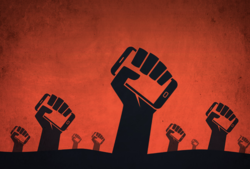Debate: A Reflection on Online Activism: Effective or Dangerous?
Digitalization has provided a powerful platform for activism: social media. Activism has become more accessible to the public, as any user can advocate a cause simply by posting Instagram stories, Facebook posts, and tweets. While online activism has been praised for its rapidity and widespread influence, its limitations have also been criticized, including the issue of misinformation. In this Debate, we explore two perspectives of viewing online activism: one on its effectiveness and the other on its underlying dangers.

The Internet has emerged as a crucial source of news. This pervasive tool has one characteristic distinguishable from traditional forms of mass media: high user participation. The Internet has empowered users to not only consume news articles but to also participate through commenting, liking, and sharing news. Moreover, users are capable of producing content to post on blogs, websites, and various social media platforms. The greater freedom held by users expanded their roles significantly: from passive consumers to key players in the production and dissemination of information. Over the past 20 years, this trend gave rise to online activism, where Internet users have become agents of sociopolitical change. From political oppression to gender equality, online activists have brought about reforms in diverse spheres of society in unprecedented ways.
One overcited, yet representative example of online activism is the Arab Spring. Facebook played an integral role in sparking a series of anti-government protests that spread across the Middle East and Northern Africa in 2010. The political movement was triggered by the death of a Tunisian man, Mohamed Bouazizi, who set himself on fire as an act of protest against police corruption and misconduct. Protestors gathered in front of the provincial government building, and videos of the protest were uploaded on Facebook in avoidance of government censorship of traditional forms of mass media. Photos and videos taken on camera phones by protesters were used actively in formal reports by professional journalists, which provided breaking news moments that could be immediately shared online. During the Arab Spring, BBC Arabic reported a fourfold increase in the use of user-generated images and photos. The Arab Spring signaled a change in mainstream journalism revolving around professional journalists and offline protests, demonstrating the ability of social media users to exert influence on the international community through the use of online communication tools.
Following the Arab Spring, countless numbers of activist movements have taken place. The Ice Bucket Challenge, aimed to raise awareness about the ALS disease and patients, went viral in 2014. Videos of people pouring buckets of ice water on their heads spread quickly on Twitter and Facebook, with participation from celebrities and prominent figures such as Bill Gates. The hashtag #BlackLivesMatter which emerged mid-2013 has been utilized to support and broaden the social movement for racial justice fueled effectively by rage against institutionalized racism. Other familiar hashtags, such as #MeToo, #HeforShe, and #DressLikeAWoman, have continuously publicized instances of misogyny, increasing media attention and coverage on issues of gender and power.
Hashtags circulate quickly. While face-to-face networks require more personal connection and time between actors, social media networks tend to be more fluid and dispersed. Take Twitter for instance. According to Networked: The New Social Operating System, 83% of all Twitter users are within five steps of interconnection. On average, half of Twitter users are merely four links away from each other. The conciseness of the message in the form of a tweet, as well as the retweet function further amplifies the rapid spread of information. Brief messages circulate to a wider audience in a shorter amount of time, and such convenience in advocating a cause offers a significant advantage in activism.
Hashtags have achieved much more than igniting public discussion of certain social issues, although this in itself is a notable accomplishment. The Ice Bucket Challenge brought Lou Gehrig’s disease into the international limelight and raised more than 220 million USD to ALS charities worldwide. Black Lives Matter incited legislative changes regarding police brutality, such as laws restricting chokeholds and duty-to-intervene policies in some US states that require police officers to intervene in the use of excessive force. The MeToo movement has led to bans on nondisclosure agreements in sexual misconduct cases, the expansion of sexual harassment laws to protect independent contractors, as well as reformations to the process of reporting sexual harassment by Congress.
Though people may argue on the extent to which progress has been driven by online activism, the significant contribution from online activists is unquestionable. On a hopeful note, social media, a tool for interpersonal communication, and also a powerful tool of mass communication, has and will continue to catalyze activist movements in ways that were not possible offline.

